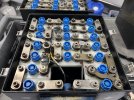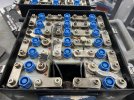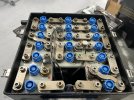As I recall if certain types of alcohols were used to clean it would darken the white PH crystals. Could also be iron as mentioned above if the PH was allowed to remain in place for an extended time. Regardless, outside of what you stated as to the white or green residues we were always instructed to not deep cycle if it had any other colored deposits in the field and to ship it to the shop.
Interesting, I hadn't thought of that. I'll have to do more research and enlighten myself. Thanks!
Teach about nicad safety, I missed that bulletin and need to learn.
Other than thermal runaway, I know nothing about their hazards.
Maybe an osha vid?
Still new to NiCd batteries, but here's a few things I've learned thus far:
-They are shipped and stored stone-dead. This is contrary to lead-acid batteries which are basically destroyed by being fully discharged. In fact, SOP for capacity checking is draining it completely dead then giving it a full charge (usually ~6hours at various amperage intervals). We then wait a while for them to cool down before discharging at their amp-hour rating to ensure all cells maintain at least 1v.
-They must be shorted during said shipping/storage, as they will self-charge a bit if left to their own devices, much like a large capacitor. We usually do this by strapping safety wire or other shorting device across the terminal of each cell, or across the main battery terminals. Much care must be taken in this step as these cells still pack a boatload of amperage even when the entire battery is at a couple volts or less.
-Also, while fully discharging, one must also take great care in monitoring each cell. As each one gets to half a volt or so, a resistor is placed between the cell's terminals. Then a wire or metal strap as it's just about dead. This is to prevent cell reversal. Since all of the cells are linked in series and they all don't hit 0v at the same time, some can actually reverse polarity, which is very bad for the cell. So the dying cells must be bypassed to give the current an alternate path.
-This is not an easy task, monitoring ~20 cells at the same time with one pair of hands/multimeter probes, and strapping each one as they all suddenly start dropping off. Not to mention they're usually arranged in very unintuitive and confusing ways, and strapping them with straight metal too early results in sparks and lots of heat. You gotta be alert and on your A-game.
-Charging process is also different. Lead-acid batteries prefer constant-voltage charging, where the charger maintains steady voltage(barring any initial current limiting) and the amp draw slowly drops off as the battery reaches a fully-charged state. NiCd batteries are charged at a constant amperage. Typically 0.5C or half the rated amp-hours, then a 0.1C "topping charge" for a few more hours. So for a 50AH battery, the charger is pushing 25amps at whatever voltage it has to for a couple hours, then 5amps for 4-6hours. All depends on the manufacturer's manuals.
-Once the battery is fully charged, and the electrolyte solution is saturated, the excess energy is released as heat. Of course we monitor the temperature of the battery during all this as well. Too much heat is both bad for the battery, as well as a red flag for overall health.
-Distilled water is added to the cells at the end of the topping charge, both to top them off and to monitor how much water was consumed in the discharge/charge process as it is a strong indicator of the health of the cell.
-Lead acid electrolyte is sulfuric acid, which as you can imagine, is a very powerful acid at a pH of 2-3. NiCd electrolyte is Potassium Hydroxide. It's on the opposite end of the pH scale, very caustic base at 12-13. Charging is usually done with the vent caps open to prevent pressure buildup and make the servicing easier. It can bubble quite energetically (especially if overfilled). Remember, you're only adding water but what's coming out is fully-concentrated electrolyte solution. Proper PPE and adequate ventilation should be used when working with either, you do not want it anywhere on/in your body.
Check the battery box lid for deterioration. Looks like the black corrosion proofing some battery boxes use.
I didn't notice any significant deterioration but i'll take a closer look at the lids tomorrow.








